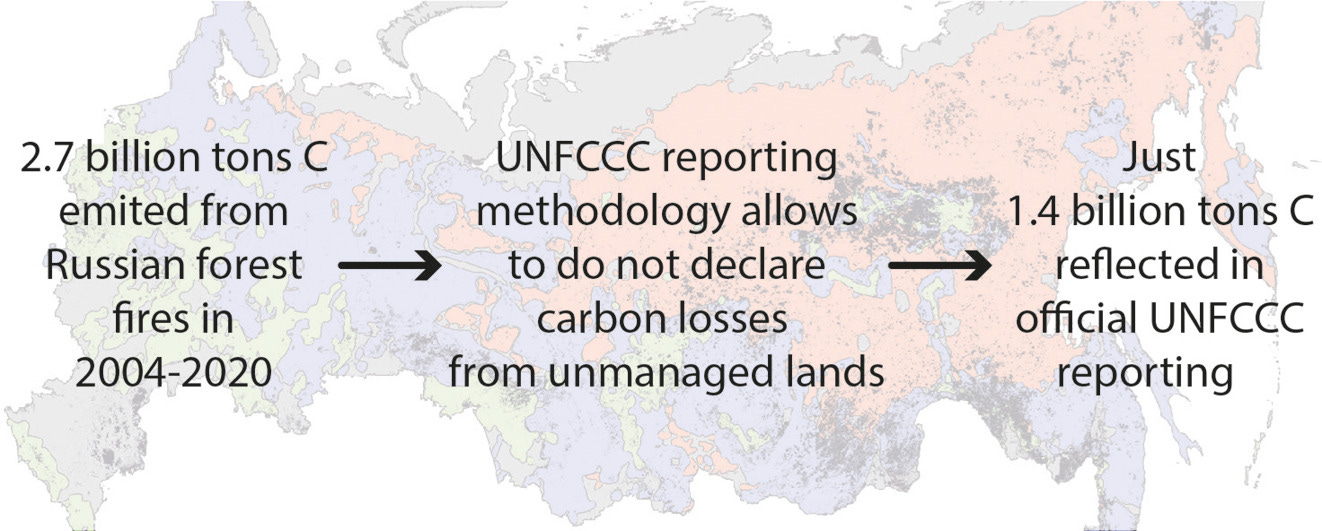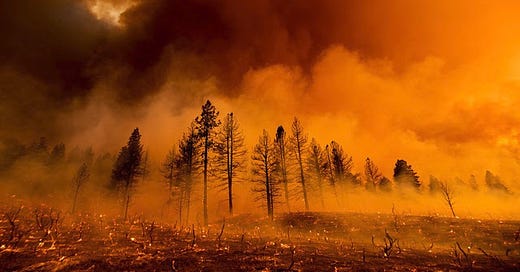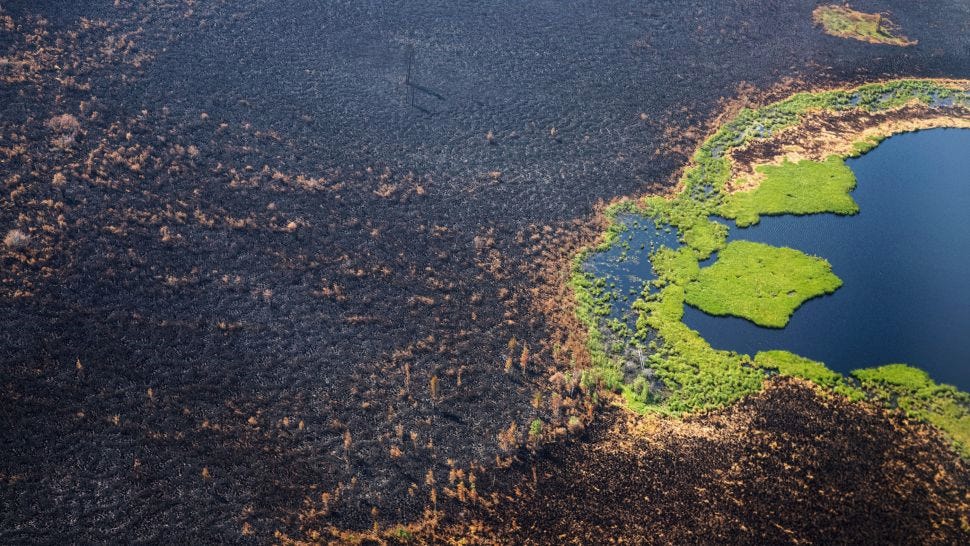The Crisis Report - 36
The World’s Forests are Burning, Ecosystem Turnover is the Cause. Let’s All be Really Clear on What that Means.
I am not a concise writer. I like to contextualize the issue I am discussing and provide a framework for understanding it. This tendency makes my climate articles run to the lengthy side. This time I’m going to try to be short and to the point.
I use the term “ecosystem turnover” frequently in my articles to explain why the planet is going to be plagued by fires on unbelievable scales for the rest of this century. The basic idea is that Global Warming is warming up the entire planet, so every ecosystem on the planet is going to change in response to that warming.
Not just “vulnerable” places, not just “some” places, every place is going to go through this. The ecosystem you live in right now is already dying.
You might not have noticed it yet, but the plants and animals have. When it reaches a tipping point where there is enough debris from the dying ecosystem laying around, fires will start happening.
It’s happening right now in the American West. As global temperatures climb the “rain-belt” is moving north. The Plains are getting hotter and drier. The West is getting hotter and drier. It's going to burn.
Despite the rains and record snowpack this winter in California. A new study forecasts that wildfires will not subside in California’s Sierra Nevada until after 2030.
“Because (by 2030) the region will likely be out of trees”
Between now and then, wildfires turbocharged by climate change are expected to dramatically alter the landscape.
Drought, Fire, Insects Destroyed Nearly a Third of Southern Sierra Nevada Forest in Last Decade - YaleEnvironment360, Oct 2022
When the existing forests are burned away, a new pulse of vegetation will grow up. In a normal interglacial warming period this new ecosystem would have centuries to develop and mature while temperatures remained relatively stable.
The normal rate of warming during an interglacial period during the last 800,000 years was about 1.0C per 1,000 years. The current rate of warming is about 0.36C per decade.
In our reality, it will have warmed enough in 20-30 years that the vegetation that replaces the current forest will begin to die. Then it will also burn.
That’s what “ecosystem turnover” means.
Just as global warming has propelled the Arctic Ocean past a tipping point that is expected to lead to a largely ice-free Arctic in summer in the coming decades, wildfire scientists say that rising global temperatures and worsening droughts mean that the world has entered a new era of megafires.
The Age of Megafires: The World Hits a Climate Tipping Point - YaleEnvironment360, Sept 2020

The “Global” part of “Global Warming” means it’s going to happen across the whole planet. There are not going to be any “safe places” to fort up in or retreat to. It’s going to happen everywhere. If it’s not happening where you live now, it will be soon.
In Alaska for example, researchers in 2019 made a projection: By the middle of this century, Alaska’s forests, now dominated by spruce, would give way to forests of deciduous trees, like birch, aspen, and cottonwood. Their conclusion,
“We’re going to lose every single spruce tree in Southcentral Alaska”.
Then, after they die, there will be fires and all that carbon will be released into the atmosphere.
It's already happening in Siberia.
Recent summers in eastern Siberia have been marked by particularly extreme temperatures — as much as 38 degrees Celsius, or 100 degrees Fahrenheit.
The forests are burning.
Siberian wildfires dwarf all others on Earth combined: Smoke just reached the North Pole in a first. Aug 2021
Fires in Siberia kill at least 10 as ‘violent winds’ fan flames May 2022
Current Siberian heating is unprecedented during the past seven millennia Aug 2022
A Warming Siberia, Wracked by Wildfires, Nears a Crucial Threshold Nov 2022
Nearly 23 million acres burned from 1982 to 2020. But almost half of that occurred in 2019 and 2020, and the region may be near a threshold beyond which extreme fires become more common.
When they burn, CO2 is released.
Siberia’s massive wildfires are unlocking extreme carbon pollution - Aug 2021
The fires have released roughly as much carbon as Germany does in a year and sent plumes of smoke spilling over the North Pole.
Siberian wildfires double greenhouse gas emission record: This is how they look from space. -August 2021
Wildfires in Siberia have emitted more carbon dioxide in two and half months than the world's sixth most polluting country emits in a year.
This is how much carbon wildfires have emitted this year -Dec 2021
Wildfires emitted 1.76 billion tonnes of carbon globally in 2021, Copernicus said. That's equivalent to more than double Germany's annual CO2 emissions.
Record-high carbon dioxide emissions from boreal fires - March 2023
There were record-high carbon dioxide emissions from boreal forest fires in Northern Canada and Siberia in 2021 continuing a trend that has been going on since at least 2000, according to new international research presented at the annual meeting of the American Association for the Advancement of Science (AAAS) in Washington DC. While boreal fires usually account for 10% of global fires’ carbon dioxide emissions, they contributed 23% in 2021, the study authors reported.
The researchers warn that boreal ecosystems are poised to become perhaps the dominant source of intensive fires and carbon emissions from fires in the future.
‘Another way of putting these emissions from 2021 into context is that it is roughly double the emissions in that year from aviation,’
That’s a feedback that is going to amplify and accelerate the warming we started with the “carbon bomb” we dumped into the atmosphere between 1990–2020 (50% of all human carbon emissions in just those 30 years).
The IPCC reports and forecasts still don’t fully factor in feedbacks like this, because the science is emerging and uncertain. Discussing feedbacks is still too speculative for them to put into the final reports, because feedbacks have the potential to set off a cycle of apocalyptic warming.

That doesn’t mean they don’t exist. It just means that we don’t know how much damage they’re going to do. We don’t know how hot it’s going to get or how fast it’s going to happen.
Ecosystem turnover and wildfires could rise global temperatures an additional 1–2C by 2100. On top of the 3-4C caused by our direct CO2 pollution.
That’s what “ecosystem turnover” means.
It’s going to get HOT this year.
After 2022’s devastating heat waves and wildfires, scientists warn of even hotter year Jan 2023
Mercury soared above 40C across many parts of Europe in 2022, leading to many deadly wildfires and heat-related deaths.
UN’s weather agency: 2022 was nasty, deadly, costly and hot - April 2023
Killer floods, droughts and heat waves hit around the world, costing many billions of dollars. Global ocean heat and acidity levels hit record highs and Antarctic sea ice and European Alps glaciers reached record low amounts, according to the United Nations’ climate agency’s State of Global Climate 2022 report released Friday.
El Niño is coming, and ocean temps are already at record highs – that can spell disaster for fish and corals -April 2023
It’s coming. Winds are weakening along the equatorial Pacific Ocean. Heat is building beneath the ocean surface. By July, most forecast models agree that the climate system’s biggest player – El Niño – will return for the first time in nearly four years.
World could face record temperatures in 2023 as El Nino returns - April 2023
Climate models suggest that after three years of the La Nina weather pattern in the Pacific Ocean, which generally lowers global temperatures slightly, the world will experience a return to El Nino, the warmer counterpart, later this year.
"El Nino is normally associated with record breaking temperatures at the global level. Whether this will happen in 2023 or 2024 is not yet known, but it is, I think, more likely than not," said Carlo Buontempo, director of the EU's Copernicus Climate Change Service.
With the HEAT will come FIRE.
Which is why, for the rest of your life, your kid’s lives, and your grandchildren’s lives the planet is going to have red sunsets and smoky air.
Are we all CLEAR now on what's happening?
This is my analysis.
This is what I see.
This is my “Crisis Report”
-rc 04222023
Personal Thoughts:
You see a lot of idiots on social media who parrot Climate Action Resistor talking points. Arguing that Global Warming is going to thaw huge new swaths of land in the Boreal North for farming and development. That may eventually be true in a few hundred years.
If you move there now, you will get burned out before 2050. Probably sooner.
Don't do that.










Thank you for the article and all the links to more information. It's appreciated.